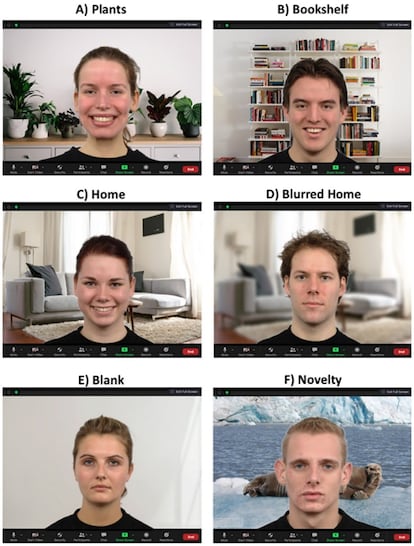The background of a Zoom call is the new business suit
According to a study, the first impression a person makes in a virtual meeting depends on what shows behind

Ever since meetings went virtual at the beginning of the pandemic, they have become part of our new professional routine. More than 200 million people a day met on Zoom during March 2020. But the first impression that a person makes in these digital sessions is not the same as that of a face-to-face encounter; according to a study recently published by the magazine PLOS ONE. The background, the facial expression and the gender affect the perception of trustworthiness and competence of a person.
“First impressions are significantly influenced by contextual visual factors, […] therefore video background could differentially impact first impression evaluations compared to in-person meetings,” the study reveals. If the virtual appearance in a Zoom or Teams meeting is considered “more important than clothing,” the background of a video call has become the new business suit. In job interviews, 97% of job applicants are seen as more competent for dressing formally and thus conveying ability, maturity, and success.
In the study, carried out by researchers at Durham University (United Kingdom), 167 participants assessed the perception of trustworthiness and competence of their colleagues, taking some variables into account. During the fictitious video calls, they were able to watch the male and female faces with happy and neutral expressions, overlaid onto six virtual backgrounds: some houseplants, a bookshelf, a living room, a blurred living room, a blank wall and a “novelty” background (an image downloaded from the internet, for example).

Those who had a bookshelf behind them scored more trustworthiness and competence points. This is due to the positive relationship between literacy with intelligence, and reading with academic performance, according to the study’s authors. To explain this result, health psychologist José Antonio Tamayo refers to the halo effect, “the tendency to associate, in our opinions about people, places, objects or situations, certain positive traits with other positive ones, without there being an empirical foundation to prove such a relationship. In the case of the setting, even if it’s virtual, it influences the formation of first impressions, and it may be that books are associated with culture and intelligence.”
Real backgrounds also arouse some curiosity on social media. Twitter user Room Rater (more than 387,000 followers) rates the backgrounds of the experts that appear on television via video call, sarcastically criticizing the objects that appear on-screen. One example of this is his review of a video call made by Leah Litman, a law professor from the University of Michigan, on MSNBC: “Good law professor setup. Travel posters are art. Teddy bear. Minor tote bag violation. 9/10.”
Good law professor setup. Travel posters are art. Teddy bear. Minor tote bag violation. 9/10 @LeahLitman pic.twitter.com/yoGVTNFTnu
— Room Rater (@ratemyskyperoom) September 26, 2023
Individuals with plants in the background were considered trustworthy because of the human connection to the natural environment. Pepe Cosín, dean of the College of Interior Designers of the Valencian Community (CDICV), explains that a space with plants is indeed more reliable, because “plants connect us with nature and instill serenity and confidence.”
According to the study, seeing other people’s houses in a work context is deemed “unprofessional,” which is why participants gave the living room background a lower rating. Virtual meetings attended from a bedroom are also considered less professional than a home office environment. Tamayo compares it to the effect that going to work in loungewear would have. Blurred, novelty or blank backgrounds were also not successful, as they were considered “untrustworthy.”
Female faces: trustworthy
Facial expressions, as non-verbal language, are important in video calls because they transmit valuable information about the feelings and intentions of others, the study reveals. A happy person is more likely to make a good impression and be more trustworthy. Smiling signals confidence and self-esteem, which translates as high agency and competence.
Women’s faces, regardless of the background that frames them, are perceived as more trustworthy and more competent. Furthermore, the confidence that emanates from a woman counteracts the negative results that a domestic or blurry background may have. However, the same is not true for men: the perceptions of trustworthiness and competence are not affected by their setting.
In conclusion, to make a better impression, the study recommends placing a bookshelf or some plants in the background during video conferences, avoiding artificial or domestic backgrounds (even if they are blurry) and having a smiling disposition during video calls. In 2024, when the Covid-19 restrictions are but a distant memory, 75% of business meetings are predicted to occur via videoconference; to succeed — visually, at least — some greenery and a shelf full of books might be just what you need.
Sign up for our weekly newsletter to get more English-language news coverage from EL PAÍS USA Edition
Tu suscripción se está usando en otro dispositivo
¿Quieres añadir otro usuario a tu suscripción?
Si continúas leyendo en este dispositivo, no se podrá leer en el otro.
FlechaTu suscripción se está usando en otro dispositivo y solo puedes acceder a EL PAÍS desde un dispositivo a la vez.
Si quieres compartir tu cuenta, cambia tu suscripción a la modalidad Premium, así podrás añadir otro usuario. Cada uno accederá con su propia cuenta de email, lo que os permitirá personalizar vuestra experiencia en EL PAÍS.
¿Tienes una suscripción de empresa? Accede aquí para contratar más cuentas.
En el caso de no saber quién está usando tu cuenta, te recomendamos cambiar tu contraseña aquí.
Si decides continuar compartiendo tu cuenta, este mensaje se mostrará en tu dispositivo y en el de la otra persona que está usando tu cuenta de forma indefinida, afectando a tu experiencia de lectura. Puedes consultar aquí los términos y condiciones de la suscripción digital.
More information
Archived In
Últimas noticias
NASA discovers Titan doesn’t have an ocean, but a ‘slushy ice layer’ that increases possibility of life
Innocence lost in the forest of the child soldiers: ‘Each leader of the armed group had his girls’
‘Fallout’ or how the world’s largest company turned an anti-capitalist apocalyptic Western into a phenomenon
From inflation to defending migrants: Eileen Higgins and Zohran Mamdani inaugurate the new Democratic resistance against Trump
Most viewed
- ‘El Limones’ and the growing union disguise of Mexican organized crime
- Christian Louboutin: ‘Young people don’t want to be like their parents. And if their parents wear sneakers, they’re going to look for something else’
- The low-cost creative revolution: How technology is making art accessible to everyone
- ‘We are dying’: Cuba sinks into a health crisis amid medicine shortages and misdiagnosis
- A mountaineer, accused of manslaughter for the death of his partner during a climb: He silenced his phone and refused a helicopter rescue











































